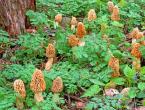Is it possible to eat morels in the spring? Spring mushrooms, oh! When to pick morels
Beginning mushroom pickers believe that it is not worth going for mushrooms before May. Like, just trample your feet.
But in fact, mushrooms appear even earlier.
Myceliums begin to wake up everywhere in different ways - depending on climatic conditions. For example, in northern latitudes it is still winter in March, but in southern latitudes field work is in full swing. It is at this time that the first mushrooms appear there. These are morels. It’s not for nothing that morels are called “scout mushrooms” and “mushroom snowdrops.” They seem to be saying goodbye to winter: there is still snow in the ravines, and wrinkled morel caps adorn the hills.
Many mushroom pickers do not take these mushrooms seriously, considering them almost poisonous. In fact, these marsupial mushrooms are classified as conditionally edible. The fact is that morels contain helvelic acid, which, if it enters the human body, can cause severe poisoning. But when boiled, this acid is completely destroyed and the mushroom can be eaten without fear. Therefore, before the main cooking, morels are cut in half, boiled for about 10 minutes, and the resulting broth is poured out. Then the mushrooms are washed. AND Only after this can the morels be boiled or fried.
Useful properties of morels
- Morels contain 3.28% protein, 0.79% carbohydrates and 0.43% fat.
- Morels contain vitamins A, B1, B2, C, PP, D, as well as useful microelements: potassium, calcium, phosphorus, sulfur, magnesium, sodium...
- Morels are used to treat eye diseases and improve vision.
- Morels improve the functioning of the gastrointestinal tract.
- Morel tincture is used externally in the treatment of rheumatism and joints.
What do morels look like?
- Morels have wrinkled caps that look like a dented honeycomb.
- The real morel has a round cap, yellow-brown in color. The leg is also hollow and grooved.
- The conical morel has an elongated cap.
- The giant morel has an almost round, cellular cap. The color of the cap is dirty gray. It received this name for its gigantic growth. The height of some morels reaches 35 cm, and the flattened cap is larger than a dinner plate.
Where do morels grow?
Morels grow wherever there are forests.
Conical morel most often found in pine forests, sometimes in deciduous ones. It grows in forest clearings, willows, among bushes, gardens and fields.
Gray giant morel less demanding on the landscape and soil composition. It is found in clay deserts, along ditches, and in bush thickets. Loves poplar plantations and shelterbelts.
If the weather is warm, humid, morels will appear in the open desert.
As long as the earth is filled with moisture, morels can be found in gardens, orchards and vineyards.
But most often, mushroom pickers go to mixed forests for morels. In sunny meadows or on old burnt-out areas, as well as near stumps, you can find true morel.
But in coniferous forests the conical morel grows.
In warm, rainy weather, the harvest of morels can be simply huge, but more than half of the mushrooms remain unclaimed. Again, due to the presence of helvelic acid in them. By the way, it is destroyed not only by boiling (this was mentioned above), but also by drying.
The genus of morels is numerous and to date science has not been able to fully study all the varieties. The reason for the lack of knowledge of some varieties is simple - they are extremely rare. But there are also morels that are familiar to every mushroom picker, because they are found in almost every forest.
Many people like the taste and aroma of this mushroom, so mushroom pickers in the forests often look for morels to fill their baskets. Based on the external characteristics that will be given below, you can easily distinguish an edible morel from any other dangerous mushroom. In addition, we will consider where and when it can be found and how it is useful.
Morels description.
The real morel belongs to the third category; it is considered a tasty mushroom, but is classified as conditionally edible. The real morel is very loved by Americans, and in 1984 it was even officially recognized as the mushroom of Minnesota. In Russia and European countries, morels are also in demand - they have good taste and are easy to recognize in forest clearings. Let's look at what characteristics you can use to recognize morels and what you should pay attention to.
- Hat.
Morels have an unusual cap shape and this makes them stand out from other species. As a rule, the morel has a spherical or ovoid cap, medium in size and very light. Along the edges, the cap fits tightly to the stem, and its maximum diameter is 8 cm, but such large specimens are rare.
As a rule, the morel cap grows up to 7 cm in height, and from 3 cm to 6 cm in width. Identification difficulties can arise due to the variability of morels - they can be painted in different shades. There are specimens with yellow-ochre, grayish and even brown caps. Mature mushrooms may become darker.
But, it is important to pay attention to the surface of the cap - in edible morels it is necessarily wrinkled, with many cellular grooves, separated by folds. The surface of the cap is similar to a honeycomb. It is noteworthy that the folds separating the recesses may be slightly darker or colored in a more saturated shade than the cells themselves. The spores are yellowish in color and can be ovoid or granular in shape.
- Leg.
In morels, the legs are cylindrical in shape and may widen slightly towards the base. The inside of the cap is hollow, the void inside is connected to the cavity of the cap. Initially, the legs of young mushrooms are white, rarely with a grayish tint. But as it grows, the leg darkens and acquires a creamy or brownish tint. In old mushrooms, the base of the stem is covered with gray-brown flakes.
- Pulp.
The pulp of the mushroom is brittle, loose and dry, has a waxy texture, and crumbles easily. As a rule, the flesh is white, but in old mushrooms it can turn yellow and later even acquire an ocher tint. The taste of the pulp is light, mushroom and unobtrusive, the smell is barely noticeable, combines mushroom and sweetish notes.
Where and when to look for morels?
Morel mushrooms are common in the forest zone of the Northern Hemisphere with a temperate climate. As a rule, morels grow on calcareous soils, which distinguishes them from many other mushrooms, and require sunlight and moderate moisture. Morels usually hide in grass, fallen leaves, or behind fallen tree trunks. Most often they grow under deciduous trees, they can be found in orchards and parks, and grow along streams and rivers. It is rare, but still possible, to find morels in coniferous or mixed forests. You can go looking for morels in early to mid-May, and the fruiting season usually ends in September. Provided there is a long and warm autumn, morels can be found until the end of October.
Precautionary measures.
When collecting morels, it is important to remember only basic safety rules - avoid polluted forests located close to industrial enterprises or highways.
But there are no dangerous morel counterparts in nature. Even similar but poisonous species belonging to the morel genus do not have similar characteristics and are radically different in the shape and size of the caps.
The benefits and harms of morels.
To make the morel healthy and safe, it is recommended to pre-soak or boil it. The minimum duration of cooking or other type of heat treatment is 15-20 minutes.
As a rule, this is enough to make the mushroom tasty, soft and safe. The pulp of mushrooms contains a useful type of polysaccharides, which helps improve vision. Based on morels, special preparations have even been created that are designed to improve vision.
In addition, morels are known as excellent immune modulators; they cleanse the lymphatic system, improve the body's resistance and stimulate hematopoietic processes. It is useful to eat morels as a choleretic product, as well as to cleanse the body of toxins - their pulp is rich in active antioxidants, which not only remove harmful substances, but also stimulate recovery processes at the cellular level.
Morels can be cooked and consumed immediately after cutting, but in ice cream, pickled and dry form they are just as tasty and healthy!
Morels photo.



If you are a passionate fan of picking mushrooms and don’t want to wait until you can pick summer and autumn mushrooms, then you can go to the forest for spring mushrooms - morels. Although at first glance the morel is not very attractive, its taste is not inferior to other types of mushrooms.
The morel has a long stem and a cone-shaped cap.
When do morels grow?
The first morels can be found already in April, but experienced mushroom pickers say that April morels are not tasty enough and are too watery and it is best to collect morels in May. Morels grow until the end of May, and in June, if you come across these mushrooms, then only a few.
Where can you find morels?
Morels are a gregarious species of mushroom and usually grow in numerous families. Most often, morels can be found in coniferous forests at the edges of the forest. Morels are also found in clearings, forest clearings and thickets of bushes. You can try to look for morels in Abkhazia when you come on vacation to the boarding house “Boxwood Grove”. And even if you fail to find these mushrooms, you will be satisfied if you buy tours on rest to this country. Even more often, morels can be found in forest fires.
The danger posed by morels
Morels are considered conditionally edible mushrooms. It is best to soak them for 3 - 4 hours in salt water before using them, or before preparing the main dish of these mushrooms, cook them in salt water and then rinse them. Morels are very easy to confuse with strings - these mushrooms are very similar in appearance. These lines are very poisonous; they contain a lot of toxins and carcinogens. Poisoning will ruin your holiday boarding house, hotel or hotel.

The leg of the lines is almost invisible
How not to confuse morels and lines?
The morel stem and cap are almost the same in length. In appearance, the morel is a bell-shaped cap on a long stem. In the lines here, the leg is practically invisible. The morel has both a cap and a stem that are hollow inside. Convolutions are found only on the surface of the mushroom body. And inside the lines there is a twisted flesh in both the stem and the cap of the mushroom.
Happy quiet hunting!
Morels and strings are considered edible spring mushrooms. The first mushrooms appear already in early April on thawed patches warmed by the sun. They acquire a full, pleasant taste only in May. Markets in Rybinsk have already started selling morels.
Morel stitch discord
Any morel differs from a strochka in shape: morels have an ovoid, elongated cap, often similar to a cone; the lines have an irregular spherical shape, as if a sheet of paper had been crumpled, their shape resembles a brain or a walnut.
This is what morels look like

This is what the lines look like


Table: what is the difference between a morel and a line
| Morel: conical, tall, edible | Stitch: regular, giant | |
| Cap color | yellow-brown, black-brown brown or dirty brown, grayish-black, ocher-yellow, gray, brown, olive-brown, black-brown | brown, dark brown, yellowish or yellowish-ocher, yellowish-brown, reddish-brown, color greatly depends on location and growing conditions |
| Cap surface | strongly protruding folds or ribs, cells similar to a honeycomb | the cap is folded, has numerous convolutions, is divided into many lobes, its surface appears velvety |
| Cap shape | narrow, conical or ovoid, ovoid-rounded, less often flattened-spherical | irregularly rounded in shape, reminiscent of a brain or a walnut. |
| Leg | cylindrical, slightly thickened at the base, hollow inside (forms a single cavity with the cap), brittle, whitish, but darkens with age, becoming yellowish, creamy, brown | the edges of the cap are connected to the stem, which is usually irregular in shape, short, wrinkled, grooved-folded, often immersed in the soil, hollow inside, whitish, quite often completely hidden by the cap, sometimes has a yellowish-pinkish tint |
| Mushroom inside | hollow | hollow |
How to eat morels and lines?
In reference books we find the following information: morels and strings are considered conditionally edible mushrooms. What does it mean? The lines contain a special toxin, gyromitrin, which is poisonous in fresh mushrooms. There is no reliable data on the toxicity of morels, but given the fact that morels and strings are often confused or collected in one basket (and gyromitrin is volatile), sanitary doctors in Russia consider both species as “conditionally edible” (Wikipedia).
When cooked for a long time, however, the mushroom pulp turns into a decoction, and when dried in the open air, it evaporates. Before cooking, it is recommended to soak mushrooms in cold water, since forest debris and insects often get stuck between the folds. The chopped mushrooms must be boiled for 30 minutes, drain the water, and rinse the mushrooms thoroughly. Another way: cook the mushrooms for 15 minutes, drain the first water, add water again, cook for another 15 minutes, rinse. You should absolutely not eat the broth in which these mushrooms were cooked or cook soups with them.
Boiled mushrooms are placed in a frying pan and fried. At the end of frying, add a couple of tablespoons of sour cream, simmer for 5 minutes. Serve with potatoes or buckwheat.
Experienced mushroom pickers collect both strings and morels. True morel, conical morel, tall morel, ordinary morel and giant morel are suitable for food. For the taste, many mushroom pickers prefer the strings (giant ones), believing that morels are less tasty.
But it is the lines that should be eaten with caution! For some people (especially children) with weak digestive systems, even small amounts of the toxin can be dangerous.
Where do morels and strings grow?
Strogs live in burnt areas and sandy soils. They can be found under coniferous trees, in deciduous and mixed with birch forests, often near birch trees or old stumps lying on the ground, on forest edges and other well-warmed places. The lines often grow in rather large groups.
Morels often grow in coniferous or mixed forests, in well-lit edges and clearings, in gardens and parks, growing in clusters or solitarily. Favorite places: floodplain forests, aspen forests, dead alder, as well as places where the soil is damaged: roadsides, slopes of ditches and ravines, fireplaces, ruins, etc. They grow well near ash trees. Morels also prefer light deciduous forests, grassy, sheltered places: lawns and forest edges, under bushes, in clearings and clearings, near fallen trees, along ditches and along the banks of streams.
The tall morel is rare and in small quantities. It grows on the soil in coniferous and deciduous forests, often in grassy meadows and edges, in gardens and orchards. It also lives in the mountains.
Our experiment
Armed with theoretical knowledge, on May 13 we decided to conduct an experiment and for the first time went into the forest in search of spring mushrooms: morels and strings. We looked for them where we usually collect boletus, boletus and boletus in abundance in summer. An hour and a half search, alas, turned out to be fruitless.
But while walking through the forest, they discovered a forest monster...

... young shoots of lilies of the valley, ...

...enjoyed enough of the rustling of leaves and sweet forest landscapes.



All they brought from the forest was pollen on their boots and a sea of impressions!

Nature is blooming, and the summer mushroom season with noble white mushrooms, aspen boletuses, and chanterelles is just around the corner!
Do you collect spring mushrooms?
The main growing and harvesting season for most mushrooms is late summer - early autumn. Some species, which are not numerous in the middle zone, ripen earlier and appear together with snowdrops and lilies of the valley. Morel mushrooms belong specifically to this spring category.
Light, hollow inside, fragrant morels with a characteristic cellular-folded surface belong to the class of Pecizomycetes and constitute a separate genus of morels. Let's look at the main conditionally edible species.
Conical
Conical morel (Morchella conica), another name is tall morel. Has the following characteristics:
- the cap is up to 10 cm in diameter and up to 5 cm in height, distinctly pointed towards the apex (bell-shaped-conical). On the cellular surface, dark brown, almost black, vertically oriented protrusions alternate with depressions of brown-tobacco color. In the lower part it fuses with the leg;
- spores are white or creamy;
- the leg is hollow, white. It grows in height up to 10 cm, reaches an outer diameter of 5 cm. The surface is uneven, granular or mealy;
- The pulp is tender, with a pleasant nutty-mushroom aroma.
Ordinary

Common morel (Morchella esculenta), another name is edible morel. The characteristics characteristic of this species are:
- the cap is ovoid, round, conical-bell-shaped, grows to a height of 12 cm and a diameter of 10 cm, hollow inside. A surface with pronounced cells that separate thin partitions from each other. At first it is dark brown, later it becomes lighter due to maturing spores;
- spores are brown with a tint of ocher;
- the stalk is hollow, widened towards the base, with a powdery surface, yellowish, creamy, up to 6 cm in diameter, up to 15 cm in height. In the upper part, the stalk directly fuses with the cap, so there are no plates as such;
- The pulp is light, from whitish to light brownish. It has a subtle pleasant smell and taste.
Semi-free

Semi-free morel (Mitrophora semilibera) is a small mushroom, noticeably different in appearance from the conical and ordinary ones. The species description is as follows:
- the cap is conical, tapering towards the apex, dark, cellular-folded, gray-brown, with a pronounced rim below that separates it from the stem. The lower diameter reaches 2.5 cm, height – 4 cm;
- cream-colored spores;
- the stalk is white to yellowish, gracefully elongated, hollow, with a powdery surface, growing up to 10 cm in height and 2 cm in diameter. It is thicker at the base;
- The pulp is creamy, thin, with a pleasant mushroom smell.
Distribution and fruiting season
Morels grow in European, Asian, and North American forests; they are collected in gardens and parks. The common morel even inhabits Australia and Tasmania, and in Minnesota (USA) it is recognized as the official state mushroom.
They prefer a temperate climate, light grassy places, light calcareous soils. They readily settle in deciduous and mixed forests, in old burnt areas, ripen in clearings and clearings, in plantings, sprout on lawns, and grow in apple orchards.

Morels bear fruit in the spring months - in Western European forests these first mushrooms of the year can be picked already in March, in Russia, as a rule, only in April-May. Sometimes, in a particularly warm and mild autumn, they regrow in October.
Similar types and differences from them
Simultaneously with morels, strings of mushrooms somewhat similar to them appear in the spring forests. However, an attentive collector can easily distinguish them.
The stitches do not have cellular, but folded caps with deep winding grooves. They grow into irregularly rounded forms that look like brown velvety curly “clouds”. Lines grow mainly in light pine forests.
Despite the pleasant mushroom smell, the raw pulp of the strings is poisonous. Even when boiled, its toxic components do not decompose completely, so it is recommended to dry the stitches in the open air for at least six months. During this period, the toxic substances evaporate without a trace and the mushrooms finally become edible.
Primary processing and preparation

Fragrant spring morels contain toxic compounds that either boiling or drying eliminates. Before preparing them, cellular fruiting bodies are first of all cleaned of sand that accumulates in numerous cavities. Then the mushrooms can be dried in a ventilated area for at least 3 months, or boiled in three times the volume of water for 20 minutes. Drain the broth completely and rinse the morels. After that, they are fried, stewed, added to the sauce and enjoyed the famous delicious taste.
Useful and healing properties
Conical morel, semi-free morel and ordinary morel contain vitamins A, PP, phosphorus and calcium. This set is useful for vision, metabolic processes and bone tissue.
In addition, these mushrooms contain complex medicinal substances, which:
- strengthen the eye muscles. As a result, senile farsightedness is corrected;
- prevent clouding of the lens and, thus, provide prevention of cataracts;
- increase appetite, help cope with asthenia and anorexia;
- have an analgesic effect. Alcohol tincture of morels has long been used for rubbing against radiculitis and rheumatism;
- improve digestion, promote effective absorption of nutrients;
- raise general tone, are antidepressants;
- have antimicrobial and antiviral activity, increase immunity.
Contraindications
Despite the impressive list of beneficial and medicinal properties, the active ingredients of morels can cause harm, especially in vulnerable conditions of the body. The use of these mushrooms and drugs made on their basis is contraindicated in the following cases:
- serious cardiovascular diseases;
- pregnancy and lactation;
- individual intolerance;
- under 12 years of age.
Unusually early mushrooms, spring morels, are a popular collection item around the world. If they are properly prepared and consumed, they fully reveal their delicate taste, delicate aroma and healing properties.






